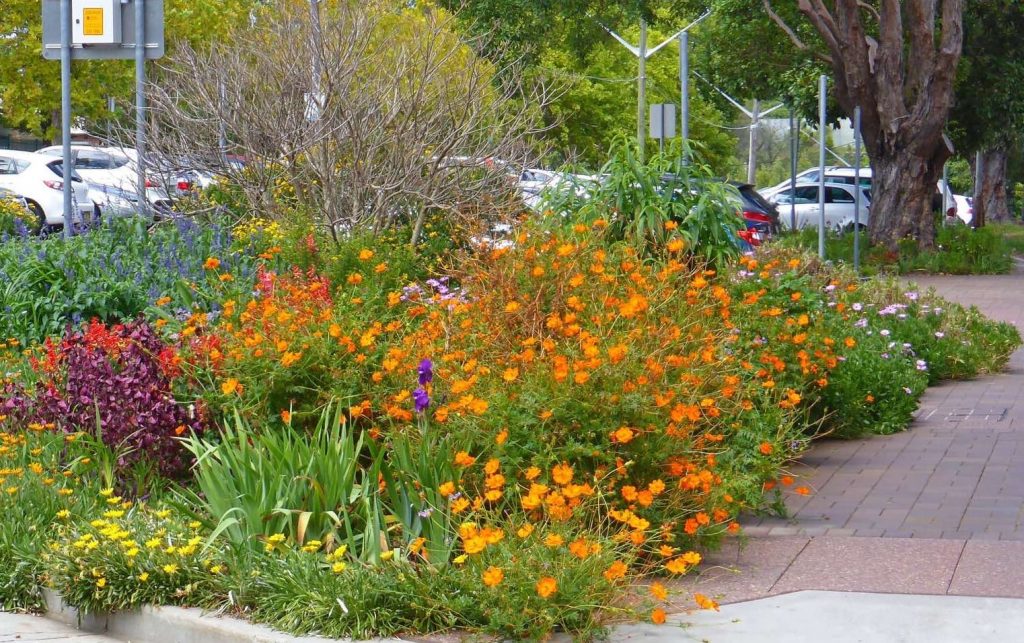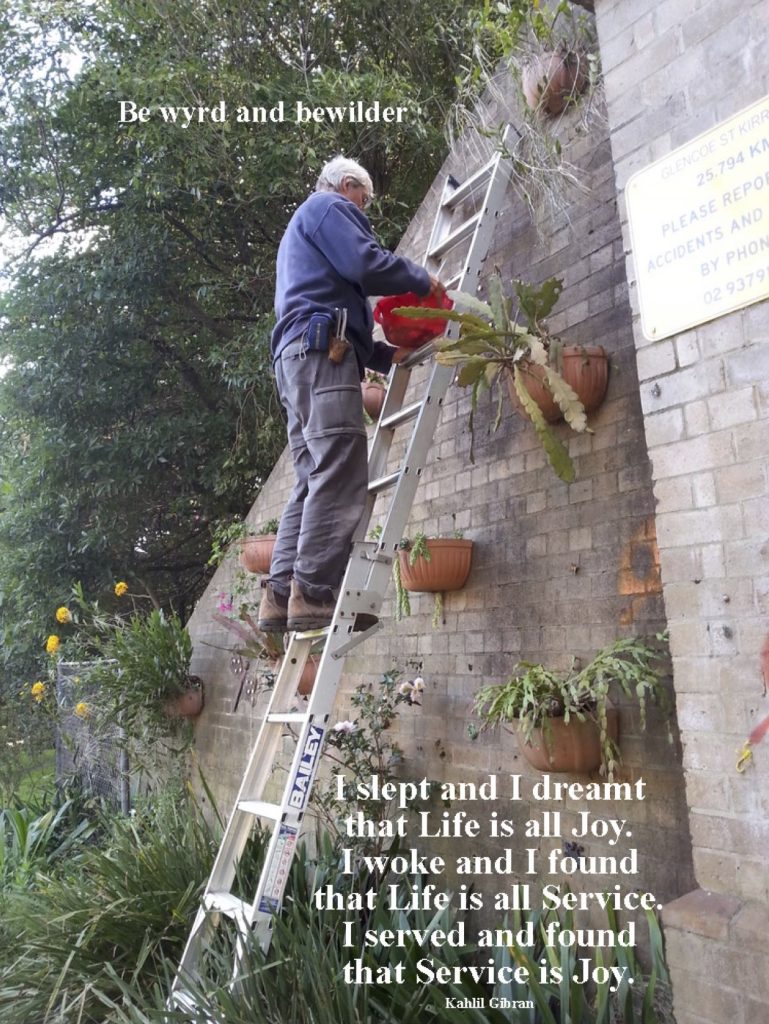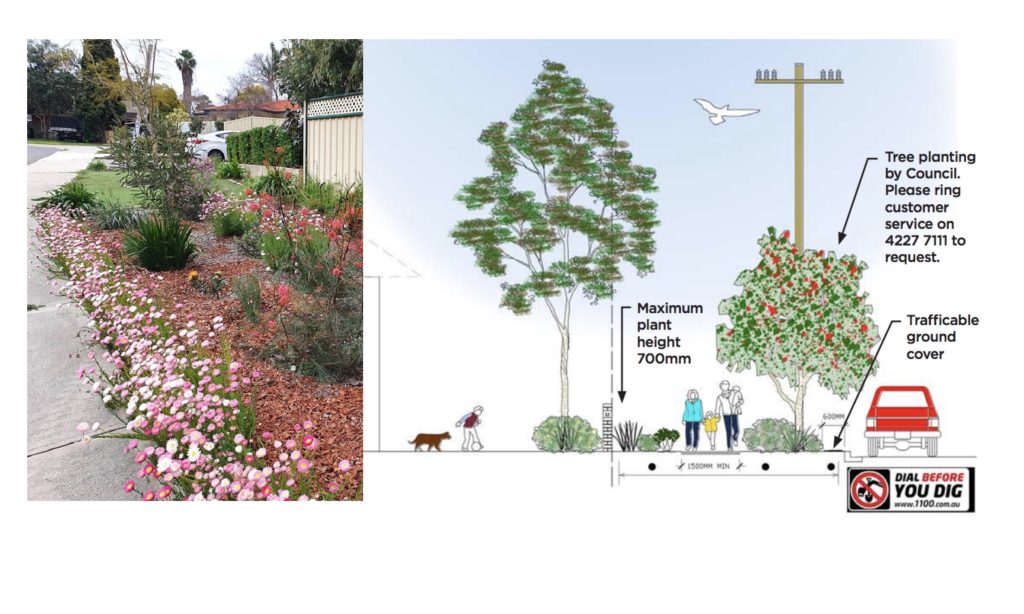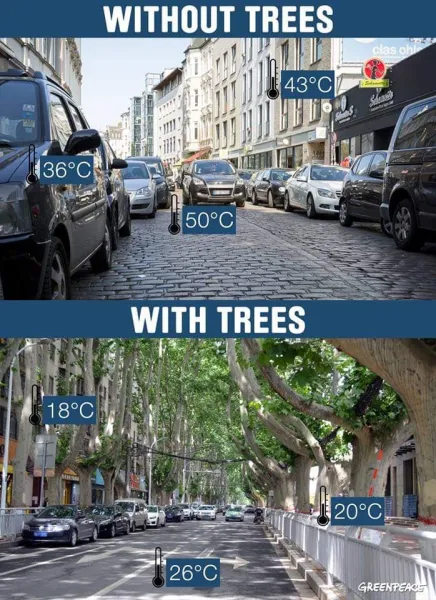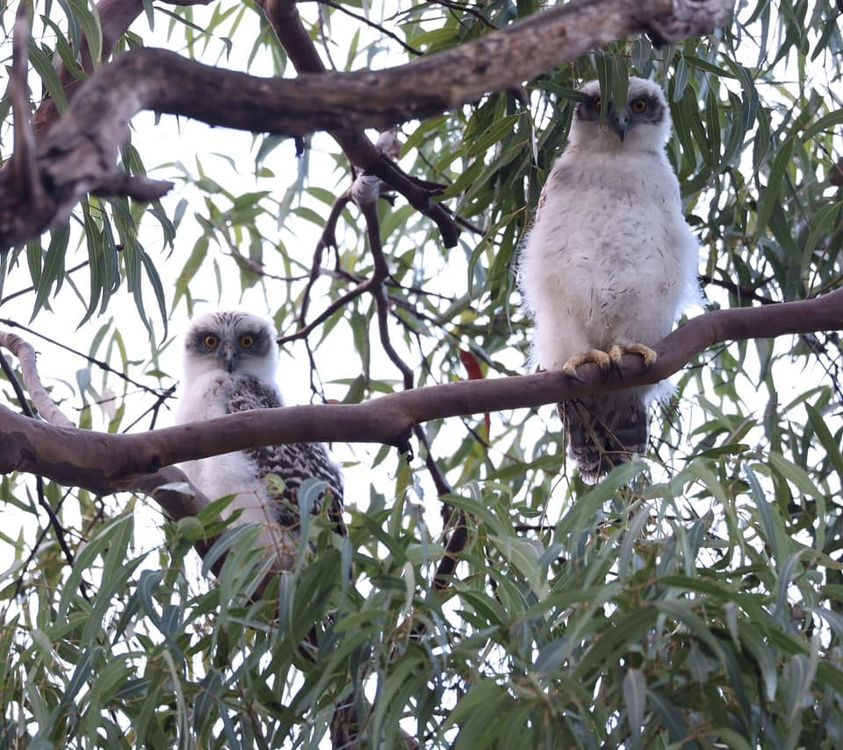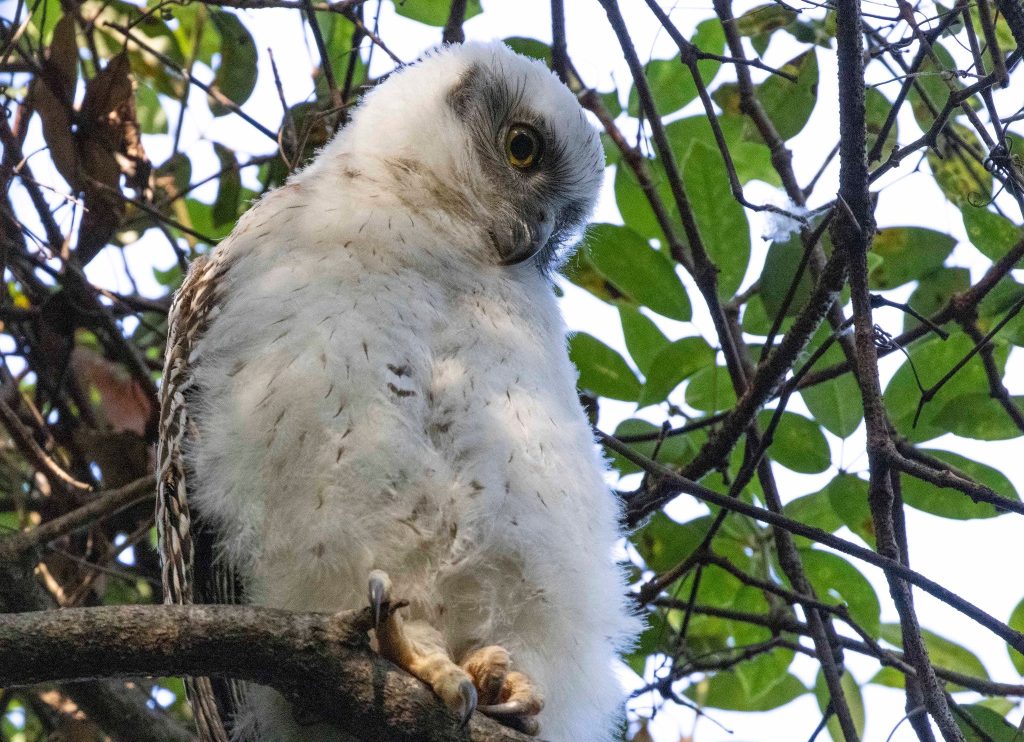Imagine if Sutherland Shire were abundant with vegetation and habitat – in our yards, our public spaces, our nature strips and even industrial areas. Everyone loves a beautiful garden enhancing the places we inhabit, healthy spaces for us, which also allow wildlife to share these areas with us. This page focuses on two aspects of that green adundance: verge gardens, and trees, specifically as these ‘speak’ to current Council policies.
Verge gardens and bewildering
Bewildering is about creating beauty with vegetation, supporting biodiversity, establishing habitat for native species, and improving the quality of life we live.
Bewildering is a very deep human response to our relationship to our world especially our immediate environment that recognises our place in it, our dependence upon it, and our responsibility to it. It is more than a charming term; it is a term for charming. It is not just such things as planting trees, greening, cuddling koalas and saving whales.
One Bewildering initiative is our advocacy for verge gardens across the Shire. We’ve been discussing the need for formal Verge Gardens Guidelines with Sutherland Council for some years. David Ackroyd, formerly of Council, prepared a set of draft guidelines which were given to various Council departments.
We have been advised that Council “supports street verge garden in principle”, however all residents must request permission in writing, detailing “plant species, design specifications, and materials to be used”. Advice on the Council website is that residents can plant low growing (less than 0.5m) soft foliage plants on verges as long as approval in writing is obtained prior.
Council seems to view verge gardens as a “risk” that needs to be managed, and has advised that verge gardens that do not comply will be removed. At the same time the advice is that residents are expected to maintain nature strips ‘as part of their civic duty’.
Verge gardens can be beautiful, and other councils manage these effectively to ensure public safety and access. Here is a list of 67 Councils across Australia that have adopted similar policies: https://shadylanes.com.au/directory/directory-category/councils/
There is no reason why Sutherland Shire Council should be any less able to do so.
In March, 2022 Sutherland Shire Councillor Diedree Steinwall put forward a motion calling for Council staff to produce a report assessing issues and identifying a framework to develop a verge garden program, with clearer and more transparent information available to the community. This motion was passed unanimously by all Sutherland Shire Councillors, but almost a year later we are still waiting for the report.
Meanwhile residents are advised they still need to seek approval for every new verge garden they want to install.
If you put in a request please keep us updated.
The relevant officer is Council’s Road and Pathways Team Leader, Babee Palanivel, who can be contacted on 9710 0387 or at bpalanivel@ssc.nsw.gov.au
______________________
For further information please contact Bob Crombie bobcrombie@hotmail.com
______________________
Sutherland Shire Council’s draft Urban Tree and Bushland policy
The rhetoric on social media about trees representing a threat has ramped up over the last couple of years. Many people have contacted us and said they are upset about the number of trees being removed across the Shire. Others contact us with reports of beautiful mature street trees being cut down with no prior notice. People find this very distressing.
Council’s new Urban Tree and Bushland policy mentions the need to ‘Enhance and protect diverse natural habitats’, however the policy also uses terms like ‘failure’, ‘risk’, and ‘hazardous’. The language positions trees as dangerous, undermining the fact that trees are a loved and valued community asset. There were 83 submissions put in to this policy – Council in effect dismissed them all, and the policy was passed in late 2021 largely unchanged.
The back story to this is that in 2020 councillors voted themselves the right to remove healthy street trees against the advice of their own Council arborists. Following questions regarding probity, the new policy has set up a system where a panel of three senior council staff evaluate appeals from residents requesting the removal of healthy trees on public land behind closed doors, and the results of these deliberations are not publicised. The Liberal Councillors voted against an amendment that sought to include a community representative on the Panel making this decision.
Under this new Urban Tree and Bushland policy there is no requirement to inform any one but immediately adjacent neighbours prior to any decision to remove healthy street trees.
So we now have a situation where any Shire resident could wake up one morning to find street trees they love near their property being removed, with no notification whatsoever. To find out the reason why, residents are now being asking to put in freedom of information GIPA requests.
Street trees belong to a community, and community consultation should be a key feature of a democracy.
Healthy trees should not be removed without informing others in the street just because one person complains. Apart from anything else, removing trees on public land involves a considerable cost to ratepayers. Meanwhile there are no a fees charged to residents lodging an appeal to remove healthy street trees.
There are positive points in the policy: an aim to meet a “No Net Canopy Loss” target, which is mentioned in Council’s Community Strategic Plan as an objective. However Council itself has estimated this new policy is likely to result in an additional +250 trees across the Shire being removed every year. The Report does not make it clear how the “No Net Canopy Loss” objective will be achieved, whether requirements for replacement planting are being met, or properly monitored. The Council report when this policy was put before Council noted issues related to “resourcing”.
The report put to Council also refers to a proposed “canopy mapping program”, but there was no details supplied. Data related to tree removal and net gain/loss of canopy should be made public.
The report put out with the policy also suggested educating people about the benefit of trees and canopy cover – as opposed to pandering to, and deliberately escalating fears. There is no indication this has taken place. It is also still not clear what will happen to any wildlife (such as nesting birds) inhabiting these trees prior to their being cut down.
Another issue is whether Council is dealing with cases of trees being poisoned in any effective way. Recent cases have raised questions about the extent to which Council claims to protect residents can be taken seriously. No information is available about any case of tree poisoners being successfully prosecuted.
Most concerning is that there is no clear rationale why the opinion of an arborist employed by a resident wishing to remove a tree on private land has now been given precedence over the considered advice of Council’s own arborists. As we have seen in the case of private building certifiers there is the potential for this system to be abused. It is not clear whether Council is planning on keeping a register to determine if certain ‘independent’ arborists consistently support the removal of trees which Council’s own arborists have found to be healthy.
Council has been doing some excellent work recently planting thousands of native trees in public spaces, and has been publicing that widely, but it takes many years for saplings to replace canopy lost by the removal of mature trees.
An Australian Conservation Foundation analysis last year found that “Almost half of Australia’s national-listed threatened animals and a quarter of the plant species at risk are found in the largest towns and cities, and the threats are intensifying… habitat is being destroyed at a rapid rate of knots”. Large canopy trees provide critical habitat even in urban environments: old hollows can take 150-200 years to form. The larger hollows birds such as powerful owls require can take 300 years. Mature and dead trees with these hollows form critical wildlife habitat. Destroying living or dead hollow-bearing trees displaces or kills wildlife dependent on those hollows.
Mature trees are also critical for addressing climate change as they sequester carbon and reduce the urban heat island effect by producing shade that prevents the absorption and reflection of heat by hard surfaces such as footpaths, roads and buildings.
The questionable removal of trees has a detrimental effect on our environment and causes anxiety amongst those who love trees and value the leafy green canopy across the Shire.
The Shire used to be known as God’s country and the beautiful tree canopy here was part of that. We know many people understand the value of trees. It is distressing when trees we love are suddenly cut down, with birds and animals becoming homeless.
It’s shocking that the concerns of local residents who took the time and trouble to put in submissions have in effect been dismissed by Council, and the outstanding issues mentioned above have remain unaddressed.
We are not convinced this current policy in fact serves the interests of residents. If you would like to review the Council report, the submissions and the new policy in more detail, it starts on p.25 at this link.
______________________
For further information please contact: office@ssec.org.au
______________________

